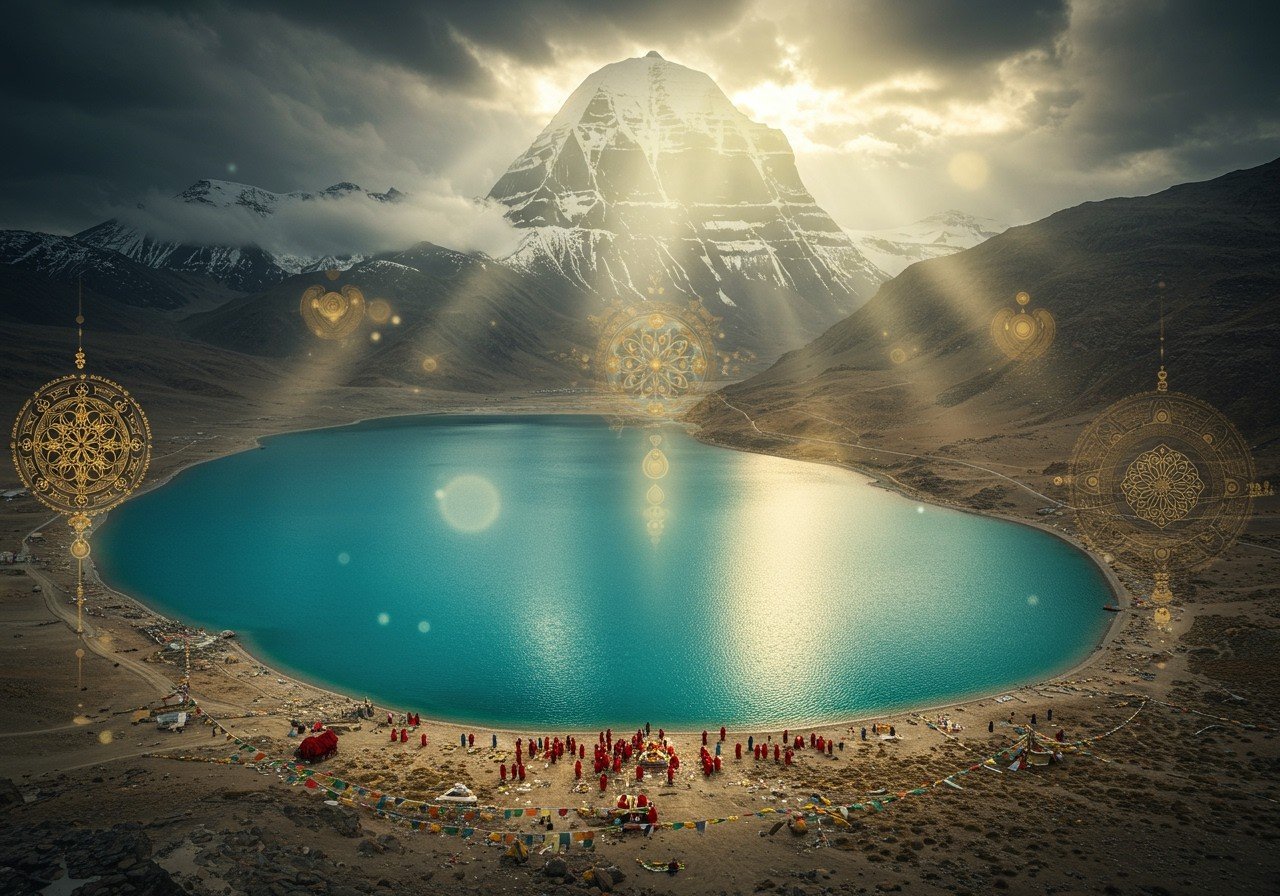
Lake Manasarovar and Lake Rakshastal, nestled in the majestic Himalayas, hold a profound spiritual significance for millions. These two contrasting lakes, located near the revered Mount Kailash, are integral to the Kailash Manasarovar Yatra, a pilgrimage resuming in 2025 after a five-year hiatus. Let’s explore the spiritual depth and logistical aspects of this sacred journey.
Introduction to the Divine Duo: Manasarovar and Rakshastal
High in the Tibetan plateau, Lake Manasarovar and Lake Rakshastal offer a captivating blend of natural beauty and spiritual symbolism. Manasarovar, with its crystal-clear freshwater, embodies purity and is revered by Hindus as the abode of Brahma. Rakshastal, a saltwater lake, stands in stark contrast, often associated with darker energies and the mythical figure Ravana. Their proximity to Mount Kailash enhances their spiritual aura, drawing pilgrims seeking enlightenment and purification. This unique location, over 4,500 meters above sea level, contributes to the region’s distinctive climate and biodiversity.
Manasarovar: The Lake of Purity
The spiritual significance of Lake Manasarovar is deeply rooted in ancient Hindu scriptures. The Ramayana and Mahabharata speak of its divine origins, linking it to Lord Shiva and Brahma. Believed to cleanse sins and bestow blessings, its pure waters draw devotees to partake in the sacred ritual of circumambulation. For Buddhists, it holds significance as the place where Queen Maya was bathed before the birth of Buddha. This rich tapestry of history and faith makes Manasarovar a beacon of hope and spiritual renewal.
Rakshastal: The Lake of Contrasts
Rakshastal, with its crescent shape and saline waters, presents a compelling counterpoint to Manasarovar. Associated with Ravana, it is often seen as a symbol of darkness and the forces opposing purity. This duality underscores the balance between good and evil present in the universe, making Rakshastal an intriguing element of the pilgrimage. Its barren shores and saline waters, devoid of aquatic life, contrast with the vibrant ecosystem of Manasarovar.
The Kailash Manasarovar Yatra: A Pilgrimage Reborn
The reopening of the Kailash Manasarovar Yatra in 2025 is a momentous occasion for spiritual seekers. This pilgrimage is more than a journey; it is a profound experience of faith and devotion.
Spiritual Significance: A Path to Nirvana
This Yatra holds deep spiritual meaning for Hindus, Buddhists, Jains, and Bon followers. Bathing in Manasarovar is believed to absolve sins and purify the soul, while the Kailash Kora (circumambulation) is seen as a path to liberation and enlightenment. The contrasting presence of Rakshastal symbolizes the challenges on the spiritual path.
Journey Details: Routes and Arrangements
For Indian pilgrims in 2025, the primary route is through Nepal and Tibet, via Kathmandu and the Rasuwagadhi-Kerung border crossing. Registered travel agencies offer comprehensive packages, handling travel logistics, permits, and accommodation. A helicopter option provides a faster alternative. The ideal travel window is from May to September, offering the most favorable weather conditions.
The estimated cost is between ₹2.75 and ₹2.99 lakhs, covering all essential services.
Preparing for the Sacred Journey: Mind, Body, and Spirit
Preparing for the Yatra involves physical and spiritual readiness. Acclimatizing to high altitudes is crucial, as is packing appropriate clothing and gear. Respect for local customs and traditions is paramount, ensuring a harmonious journey. It is also important to carry any personal medicines and consult a doctor before embarking on this high-altitude pilgrimage.
Cultural Immersion: Engaging with Local Traditions
The Yatra offers a unique opportunity to experience the rich culture of the region. Local festivals, like Saga Dawa, provide insights into Tibetan Buddhist traditions. Monasteries serve as centers of learning and cultural preservation, further enriching the pilgrimage experience. Engaging with local communities fosters understanding and respect for the region’s cultural heritage.
Poojn.in: Your Companion on the Spiritual Path
Preparing for a pilgrimage like the Kailash Manasarovar Yatra involves gathering essential items for rituals and prayers. Poojn.in, India’s leading online store for cultural and religious goods, offers a convenient way to acquire these necessities.
Sacred Offerings: Items for Lake Rituals
- Pure Copper Kalash: A traditional vessel for collecting holy water from Lake Manasarovar, symbolizing purity and blessings. Essential for carrying the sacred water back home as a memento of your journey.
- Brass Diyas: Beautifully crafted diyas for performing aarti ceremonies by the lake, invoking divine light and blessings. Choose from various sizes and designs to enhance your spiritual practice.
- Cotton Wicks and Pure Ghee: Essential components for lamp offerings, symbolizing the dispelling of darkness and ignorance. Opt for pure ghee made from cow’s milk for enhanced spiritual significance.
Prayer Essentials: Enhancing Your Spiritual Connection
- Rudraksha Malas: Sacred beads used for meditation and chanting, enhancing focus and spiritual connection during your Yatra. Available in various mukhi (faces) with specific benefits.
- Incense Sticks and Holders: Create a serene atmosphere for prayer and meditation with fragrant incense. Choose from traditional aromas like sandalwood and agarwood.
- Kumkum and Roli:Auspicious powders used in Hindu rituals, symbolizing purity and devotion. Essential for offerings and marking the forehead as a sign of reverence.
Poojn.in offers pan-India delivery, quality-checked products, secure packaging, and dedicated customer support via WhatsApp (9476142738) and phone (03369029784). Visit www.poojn.in to prepare for your sacred journey.
Embarking on Your Spiritual Odyssey
The Kailash Manasarovar Yatra in 2025 is a sacred calling, an opportunity to deepen your spiritual connection and find inner peace. Each step on this pilgrimage brings you closer to the divine, cleansing your spirit amidst the breathtaking beauty of the Himalayas. Respecting local traditions and embracing the journey’s challenges enhances the transformative power of this experience.
FAQs: Your Questions Answered
What distinguishes Lake Manasarovar? Lake Manasarovar is renowned for its spiritual significance, particularly for Hindus and Buddhists. It is believed to cleanse sins and foster inner peace.
What makes Lake Rakshastal unique? Lake Rakshastal’s saline water and association with darker symbolism make it a fascinating contrast to Manasarovar.
How do the two lakes differ? Manasarovar is a freshwater lake considered sacred, while Rakshastal is a saltwater lake with different spiritual connotations.
Where is Lake Manasarovar situated? Lake Manasarovar is located in the Tibet Autonomous Region of China, near Mount Kailash in the Himalayas.
What is the connection between Lake Manasarovar and Mount Kailash? Both are considered sacred, and pilgrims often visit both as part of their spiritual journey.
Can both lakes be visited together? Yes, the two lakes are geographically close and are often included in the Kailash Manasarovar Yatra itinerary.
In which mountain range does Lake Manasarovar lie? Lake Manasarovar is nestled in the majestic Himalayas, adding to its spiritual aura and scenic beauty.


